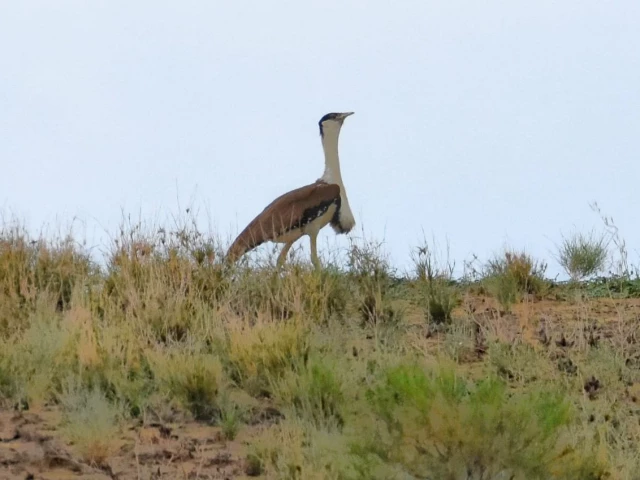Great Indian Bustard population shows recovery in Cholistan
Fragile recovery result of enhanced conservation efforts, ongoing field monitoring, creation of dedicated reserve

In a significant development for wildlife conservation in Pakistan, the critically endangered Great Indian Bustard, locally known as Bhakhar, has shown promising signs of population recovery in the Cholistan Desert, according to Punjab wildlife authorities.
Wildlife experts estimate the global population of the Great Indian Bustard to be between 80 and 90, with approximately 30 to 35 believed to inhabit the Cholistan region of Pakistan. This fragile recovery is the result of enhanced conservation efforts, ongoing field monitoring, and the creation of a dedicated public wildlife reserve.
“This bird is now restricted to the Cholistan Desert in Pakistan and Rajasthan in India,” confirmed Wildlife Conservator Syed Rizwan Mehmood.
He documented rare video footage and photographs of the species during a recent field survey.
“The sighting and documentation of its presence confirm its continued survival in Pakistan. It’s a major breakthrough.”
Bahawalpur Deputy Chief Wildlife Ranger Syed Ali Usman Bukhari emphasised the role of dedicated habitat protection in aiding the bird’s recovery.
“A designated Public Wildlife Reserve has been established in Cholistan specifically to protect the Great Indian Bustard. Strengthened conservation measures have led to a gradual increase in the population of this native species,” he said.
The Great Indian Bustard (ardeotis nigriceps) is listed as "critically endangered" by the International Union for Conservation of Nature (IUCN), making it one of the most threatened bird species in South Asia.
Once found in large numbers across the Indian subcontinent, the species is now confined to fragmented habitats in India and Pakistan due to habitat loss, hunting and human disturbance.
Renowned for its distinctive appearance, the Great Indian Bustard is among the heaviest flying birds in the world. Males can weigh up to 15 kilograms, stand about one meter tall, and have a wingspan exceeding two meters. The bird is easily identified by its brown, white and black plumage and a prominent black patch on the neck.
It lays only one egg per year, resulting in an extremely low breeding rate making every individual crucial to the survival of the species.
Under the Convention on International Trade in Endangered Species (CITES), all international trade of the species is strictly prohibited. Domestically, the bird enjoys legal protection, with all forms of hunting or trade banned.
Unlike the more commonly targeted Houbara Bustard, which has faced significant pressure from hunting by foreign falconers, the Great Indian Bustard has largely been spared due to its rarity and the strict penalties imposed on violators.
Conservationists remain cautiously optimistic. “The progress we’re seeing in Cholistan is encouraging, but the species remains on the brink,” said a wildlife official. “We must maintain and expand protection efforts, raise awareness, and safeguard critical habitats if we are to prevent its extinction.”



















COMMENTS
Comments are moderated and generally will be posted if they are on-topic and not abusive.
For more information, please see our Comments FAQ